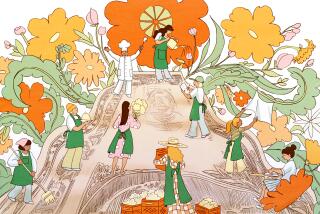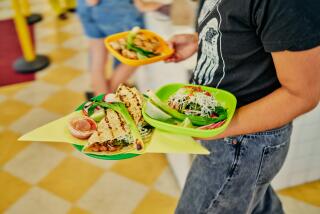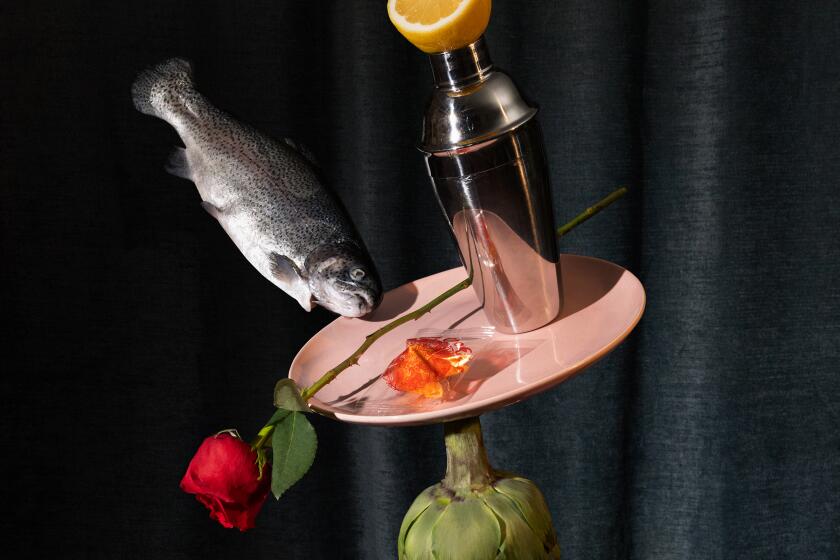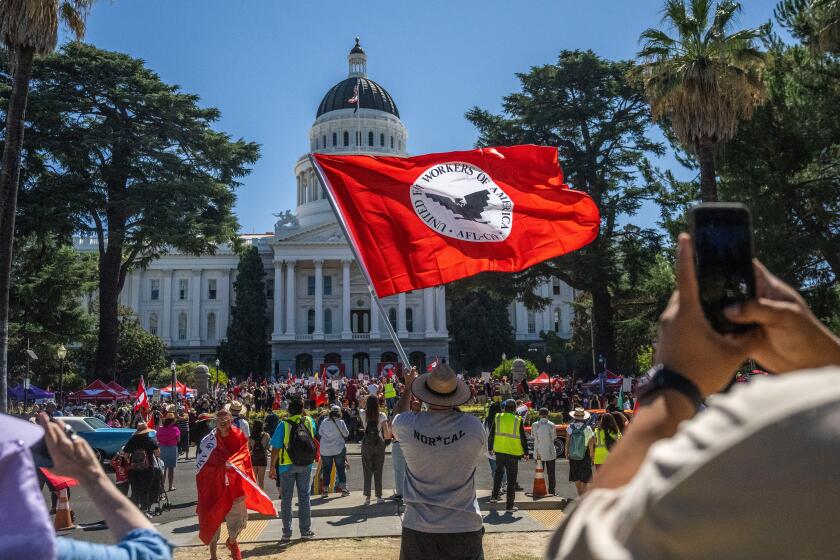Our Man in the Field: A Report From the Harvest
“Here, this is the way you pick the grapes fast,” I said.
It was harvest day.
Marc, 12, had already picked two lug boxes full; I had gotten three. He came over to ask what the secret was.
“You’ve got to get inside the vine,” I said, squeezing between the canes and tendrils and raising my serpette, the curved, razor-sharp knife used to clip off the clusters. “Watch. You just look for the green stem and you clip. But you have to watch out that you don’t cut your . . . . Ouch.”
Ultimate embarrassment. I slashed the little finger of my other hand.
Ah, but this was a productive day. Cool weather. And a happy crew that included Tor Kenward, Teresa Aldama and Mora Houston, the marketing staff at Beringer Vineyards, as well as my home-grown pickers: Marc, Adam and Joel. We got more than a third of a ton of grapes in four hours of picking.
And with only five finger cuts among us.
The harvest of 1990 was one of joy for most grape growers. Grapes throughout California ripened in timely fashion and with textbook pacing. There was no excessive heat, so everything ripened evenly, making for an orderly crushing of the grapes.
The crop in all coastal regions of the state was down from last year’s large harvest, but quality was far better than 1989, when rains caused rot and forced a lot of hand-selecting of the fruit.
Statewide this year, Sauvignon Blanc seemed to get hit the hardest. In Napa and Sonoma, the variety was off as much as 50% in tonnage due to May rains that hit just as the vines were flowering. The immature flowers were ripped off and fruit never developed--the so-called “shatter,” in which clusters look as if a series of grapes had been pulled off.
The Cabernet Sauvignon we picked at Beringer’s State Lane Vineyard was not plentiful. Bunches looked scraggly. On the bright side, Chardonnay production in the coastal regions was not hurt as badly as some other varieties.
John Fetzer, president of Fetzer Vineyards in Mendocino, said that although volume was off, the quality of the fruit was exceptional in virtually all varieties. “(Wine maker) Paul Dolan and all our wine makers were just smiling ear to ear,” said Fetzer. “We really had no need to adjust the acidity in the grapes.” He said that, on average, Fetzer’s overall crop was off 12% to 16% in volume, with the worst loss in Sauvignon Blanc.
“There was a slight amount of rain in certain areas, in mid-September and early October,” said Rich Kunde, owner of Sonoma Grapevines and of vine acreage throughout Sonoma county, “but it didn’t really amount to anything in terms of quality. And it was wonderful considering last year, when a lot of grapes were left hanging on the vines.”
Offsetting the short crop in the North Coast, he said, was additional tonnage of Chardonnay from new plantings, vines that bore no fruit last year.
In the Central Coast area of California, tonnage was slightly better than in the northern regions and quality was rated as among the best ever. Wine makers Ken Brown of Byron and Rick Longoria of Gainey both said the 1990 Pinot Noir was probably the best they had ever harvested.
In the Napa Valley, Cabernet Sauvignon volume was off 20% in many areas, but color and concentration of flavor were rated high. It was the seventh year in a row of excellent richness. Not since the lackluster vintage of 1983 has the Napa Valley experienced anything remotely resembling an off-vintage for Cabernet.
Some 700 pounds of grapes sat in small bins between the vines. It was 12:20 p.m. Picking was easier than past years, when the temperature had risen above 100 and picking took until well past 1 p.m. This day it was only 85 or so, and we were 90 minutes ahead of schedule.
Adam, 9, had picked three bins full; Joel, 6, picked half a bin and served an important role--that of leaf-picker, taking the leaves out of the bins. We loaded the bins into the small truck and drove off to crush the grapes.
At the makeshift “winery” we de-stemmed the grapes into a large, square plastic bin, then removed our shoes and socks and jumped in to squish them with our feet. Feet are the perfect tools for getting the fermentation started. They are weighty enough to press out juice, not powerful enough to break the seeds, which contain bitterness.
We made up a slurry of yeast in a small bottle and stirred the paste with a stick until it mixed. Then it was dumped into the fermenting tub. Within minutes our feet felt warm as yeast began to turn the sugar in the grape juice into alcohol.
Then we hosed off our legs and the machinery, while the kids frolicked in the spray of water from the hose, and went to lunch to sample Cabernets from our two previous harvests. Those wines are still unbottled, in barrels. Both were good. But we had hopes that the riper fruit we harvested this year would make a bigger, richer wine than the ’88 or ’89.
As we drove back over Petrified Forest Road into the setting sun toward showers and fresh clothes, Marc asked, “When will we taste that wine, Daddy?”
“When you’re 17,” I replied. It was no exaggeration.
This 1990 Cabernet won’t be bottled until early 1993; based on the depth and concentration it showed early, it’ll need time in the barrel to soften. And then the wine will be left to age in the bottle another two years, until perhaps mid-1995. Then at last it will be ready to be evaluated.
“That long!?” asked Adam. “Wow. You really have to be patient to make wine.”
Joel was asleep.
More to Read
Eat your way across L.A.
Get our weekly Tasting Notes newsletter for reviews, news and more.
You may occasionally receive promotional content from the Los Angeles Times.






